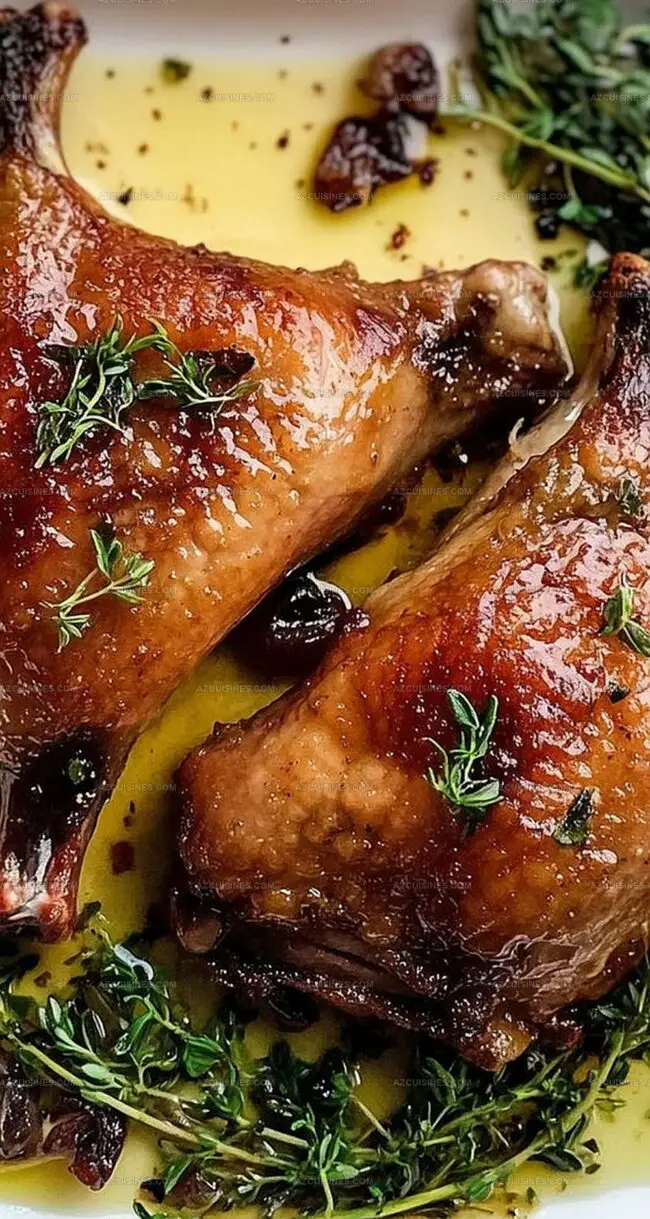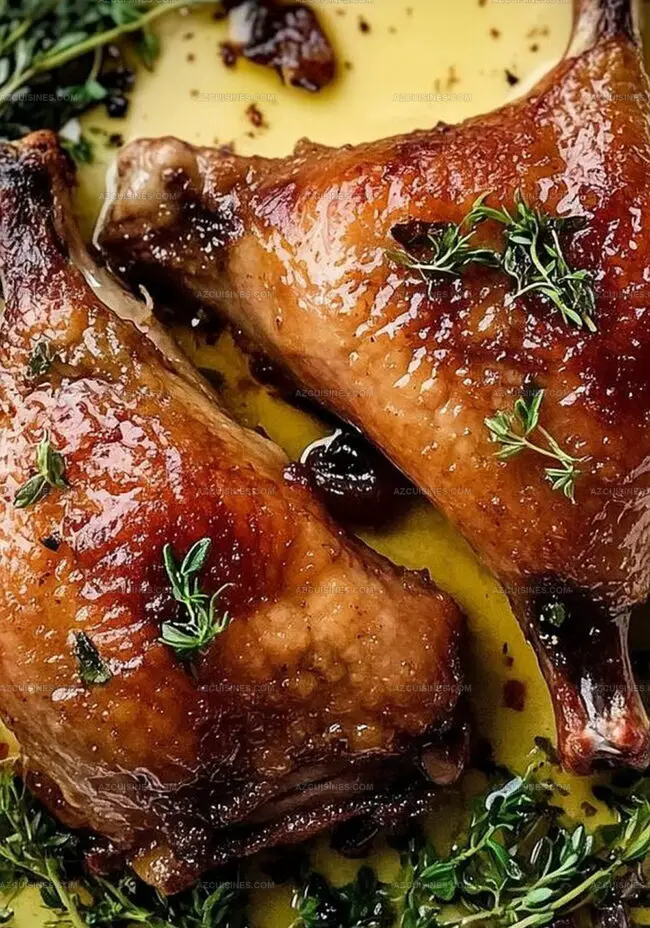The Crispiest French-Style Duck Confit Recipe You’ll Adore
Duck confit, a sublime French delicacy, promises an extraordinary culinary adventure that melts in your mouth.
Tender meat becomes the star of this classic preparation, slowly cooked to perfection.
Chefs across France have cherished this traditional technique for generations.
Each bite reveals layers of rich, succulent flavor that transport you to a rustic countryside kitchen.
Salt, herbs, and patience combine to create an incredibly luxurious dish.
Crispy skin and meltingly soft meat make this recipe a true showstopper that challenges basic cooking expectations.
Prepare to impress even the most discerning dinner guests with this extraordinary French classic.
Why French-Style Duck Confit with Crispy Skin Is a Showstopper
Ingredients for French-Style Duck Confit
Main Protein:Seasoning Blend:Cooking Fat and Liquid:Step-by-Step Duck Confit That Delivers
Step 1: Season and Marinate Duck Legs
Generously coat duck legs with salt, creating a flavorful dry rub. Crush fresh garlic cloves and sprinkle with fragrant thyme leaves, crumbled bay leaf, and whole peppercorns.
Massage the seasonings deeply into the meat, ensuring complete coverage. Wrap tightly and let the duck rest in the refrigerator overnight, allowing flavors to penetrate thoroughly.
Step 2: Prepare Cooking Environment
Set oven temperature to a low 250°F. Gently rinse duck legs under cool running water, removing excess salt.
Use paper towels to pat the meat completely dry, which helps achieve crispy skin later.
Step 3: Slowly Poach Duck in Fat
Select a deep, heavy-bottomed pot suitable for oven use.
Slowly melt rich duck fat over low stovetop heat. Carefully place seasoned duck legs into the melted fat, ensuring they are fully submerged.
Add a small amount of water to prevent direct burning.
Step 4: Slow Roast to Tender Perfection
Cover the pot with a tight-fitting lid or aluminum foil.
Transfer to preheated oven and allow duck to cook slowly. Roast for approximately 2.5 to 3 hours until meat becomes incredibly tender and starts separating effortlessly from the bone.
Step 5: Create Crispy Golden Exterior
Remove duck legs from fat using tongs.
Place in a hot skillet over medium heat. Sear each side for 3-4 minutes, developing a beautiful golden-brown and crackling skin surface.
Step 6: Plate and Serve
Transfer crispy duck legs to a serving platter. Accompany with roasted seasonal vegetables or creamy herbed potatoes.
Enjoy this classic French delicacy while it’s piping hot.
Crispy Skin Secrets for Duck Confit
Duck Confit Variations You Can Master
Best Pairings for French Duck Confit
Storing Duck Confit Like a Pro
Duck Confit FAQs, Simplified
Duck confit is a traditional French cooking method where duck legs are salt-cured, then slowly cooked in their own fat until incredibly tender, creating a rich and flavorful dish.
Salting helps draw out moisture, concentrates flavor, and tenderizes the meat, which is crucial for achieving the signature texture and taste of authentic duck confit.
While duck fat provides the most authentic flavor, you can substitute with goose fat or a blend of olive and vegetable oils, though the taste will be slightly different.
Print
French-Style Duck Confit with Crispy Skin Recipe
- Total Time: 1 day & 2.5 to 3 hours
- Yield: 4 1x
Description
Succulent French-style duck confit dances with crispy, golden skin, embodying classic Parisian culinary elegance. Rich, tender meat melts perfectly beside roasted seasonal vegetables, delivering an authentic taste of France that will transport you to a charming countryside bistro.
Ingredients
Main Ingredients:
- 4 duck legs with skin
- 2 cups (473 milliliters) duck fat
Aromatics and Herbs:
- 4 garlic cloves, crushed
- 4 sprigs fresh thyme
- 1 bay leaf
Seasoning:
- 1 tablespoon (15 grams) sea salt
- 1 teaspoon (5 grams) black peppercorns
- 1 cup (237 milliliters) water
Instructions
- Liberally season duck legs with salt, creating a robust flavor base by massaging in crushed garlic, fragrant thyme, aromatic bay leaf, and cracked peppercorns.
- Refrigerate the seasoned legs for a full day, allowing the spices to penetrate and cure the meat thoroughly.
- Wash off salt mixture under cold water, carefully patting legs completely dry with paper towels to ensure optimal fat rendering.
- Gently melt duck fat in a heavy-bottomed pot over low heat, carefully nestling duck legs into the liquid fat, ensuring complete submersion.
- Slide pot into a precisely preheated 250°F oven, covering tightly with a lid to create a slow, gentle cooking environment for 2.5-3 hours.
- Test meat tenderness by checking if it effortlessly separates from the bone, indicating perfect confit preparation.
- Transfer legs to a scorching hot skillet, rendering the skin to a golden, crackling texture over medium-high heat for 3-4 minutes.
- Plate immediately, presenting the duck with a crisp exterior and succulent interior, accompanied by roasted seasonal vegetables or herb-infused potatoes.
Notes
- Ensure the duck legs are completely dry before cooking to achieve the crispiest skin possible.
- Select high-quality duck fat for the most authentic and rich flavor profile.
- Consider making extra duck confit and storing it in the fat for up to two weeks in the refrigerator for convenient meal prep.
- Gluten-free and keto-friendly option by pairing with low-carb vegetable sides like roasted Brussels sprouts or cauliflower.
- Prep Time: 1 day
- Cook Time: 2.5 to 3 hours
- Category: Dinner
- Method: Slow Cooking
- Cuisine: French
Nutrition
- Serving Size: 4
- Calories: 500
- Sugar: 0 g
- Sodium: 500 mg
- Fat: 45 g
- Saturated Fat: 15 g
- Unsaturated Fat: 25 g
- Trans Fat: 0 g
- Carbohydrates: 0 g
- Fiber: 0 g
- Protein: 30 g
- Cholesterol: 100 mg




Truc Tran (Kris)
Senior Food Editor
Expertise
Home Cooking, Meal Planning, Recipe Development, Baking and Pastry, Food Editor, Cooking-video Maker, Vietnamese Food Evaluation Expert
Education
Truc Tran (Kris), an experienced food writer and editor, is great at exploring and describing global cuisines, from simple street food to fancy dining. In her writing, she skillfully mixes different flavors, cooking methods, and culinary traditions, showing the unique character of various cultures through their food and drinks. On azcuisines.com, Kris highlights her knowledge, especially in Asian cuisine and worldwide traditional dishes.